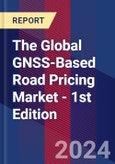How will the market for road user charging using GNSS-based systems evolve in 2024 and beyond? This report covers the latest trends and developments in the road tolling market. The report forecasts that the installed base of GNSS-based on-board units deployed for road user charging will grow at a CAGR of 7.3 percent from 7.4 million units worldwide in 2023 to 10.6 million units in 2028. Get up to date with the latest information about vendors, products and road tolling schemes.
The global installed base of GNSS-based on-board units deployed for road user charging exceeds 7 million units
GNSS-based road pricing refers to the charging of road users using global navigation satellite system (GNSS) sensors inside vehicles. The road pricing umbrella term typically covers various types of schemes such as electronic toll collection (ETC) and road user charging (RUC) as well as vignettes and congestion charging. More than a dozen countries around the world have GNSS-based RUC/ETC systems that are in operation or about to be launched in the near-term. The vast majority of these are so far located in Europe but there are also programs in operation in North America and Asia-Pacific as well. Berg Insight estimates that the installed base of GNSS-based on-board units deployed for road user charging reached more than 7.4 million units worldwide in 2023. Growing at a compound annual growth rate (CAGR) of 7.3 percent, the installed base is forecasted to reach almost 10.6 million units in 2028.
Berg Insight ranks Russia, Germany and Poland as the largest markets in terms of the number of GNSS-equipped vehicles for road user charging purposes. The Russian implementation is the largest in the world with more than 1 million on-board units in use for the Platon ETC system. Germany and Poland are the runners-up with the Lkw-Maut and e-TOLL systems respectively. Other countries with more than half a million on-board units in use include Belgium with the Kilometer Charge, Hungary’s HU-GO and the Czech Republic with the CzechToll satellite toll system. Bulgaria and Slovakia also have several hundred thousand on-board units deployed. The remaining top-10 markets are New Zealand and Switzerland with the eRUC and LSVA implementations respectively. The fragmented US market has a few operational RUC programs on state level and the country is just outside of the global top-10 so far.
The road pricing space is affected by various market drivers and industry trends that will shape the sector in the years to come. The European Electronic Toll Service (EETS) is driving interoperability in the major European market and there is a trend towards GNSS at the expense of other technologies from a global perspective. There is moreover an emerging shift from traditional windshield OBUs to also including other hardware form factors in road user charging implementations for various vehicle types. The growing popularity of electric vehicles (EVs) and associated fuel tax losses are moreover favouring distance-based RUC overall. Various value-added service offerings are furthermore facilitated as electronic tolling is converging with vehicle telematics.
Highlights from the report:
- Introduction to global navigation satellite systems (GNSS) and road pricing.
- Insights from numerous interviews with toll system operators and service providers.
- Comprehensive overview of operational GNSS-based road pricing schemes in 11 countries as well as numerous planned and potential developments in other markets.
- Profiles of 10 key companies active in the GNSS-based road user charging value chain.
- In-depth analysis of market trends and key developments.
- Market forecasts lasting until 2028.
Key questions answered:
- What different types of players are involved in the road user charging value chain?
- What regional differences are there between markets?
- How is the European Electronic Toll Service (EETS) impacting the market?
- What technologies are used for electronic toll collection and road user charging?
- Is the growing popularity of electric vehicles affecting the road user charging space?
- Which other trends and drivers are shaping the market?
- How will the GNSS-based road pricing market evolve in the future?
Who should read the report?
The Global GNSS-Based Road Pricing Market is the foremost source of information about the market for electronic toll collection and road user charging based on global navigation satellite systems (GNSS). Whether you are a toll system operator, technology supplier, service provider, telematics vendor, telecom operator, investor, consultant, or government agency, you will gain valuable insights from this in-depth research.
Table of Contents
Executive Summary
Companies Mentioned (Partial List)
A selection of companies mentioned in this report includes, but is not limited to:
- Axxès
- Continental
- Emovis
- EROAD
- Eurowag
- ITIS Holding
- Kapsch
- Telepass
- Toll4Europe
- TotalEnergies








